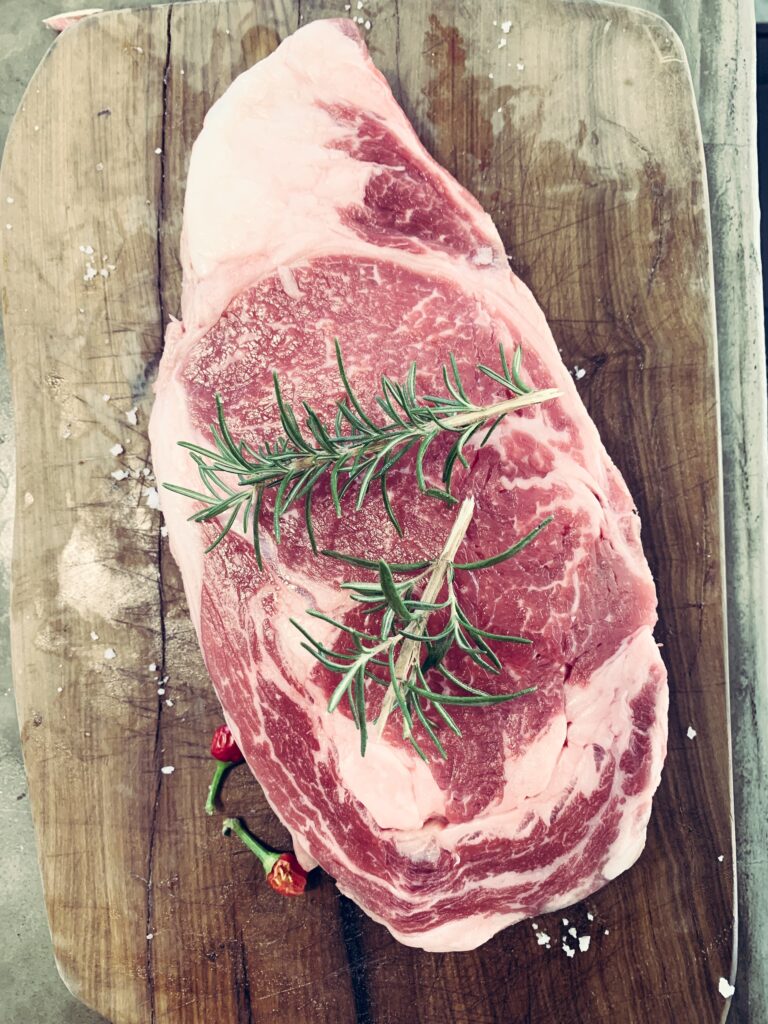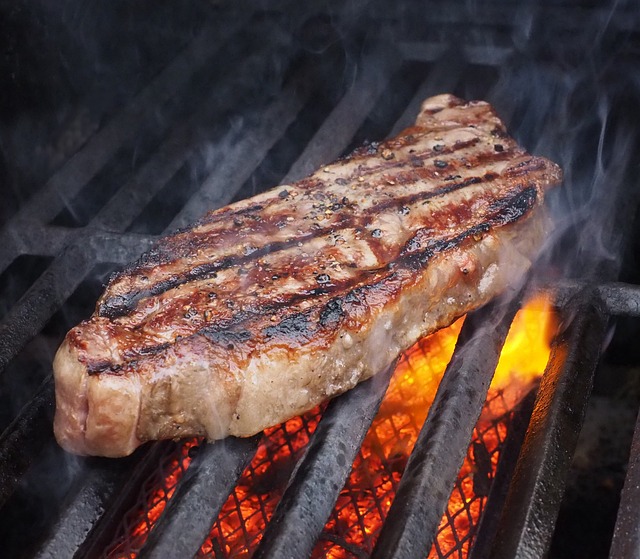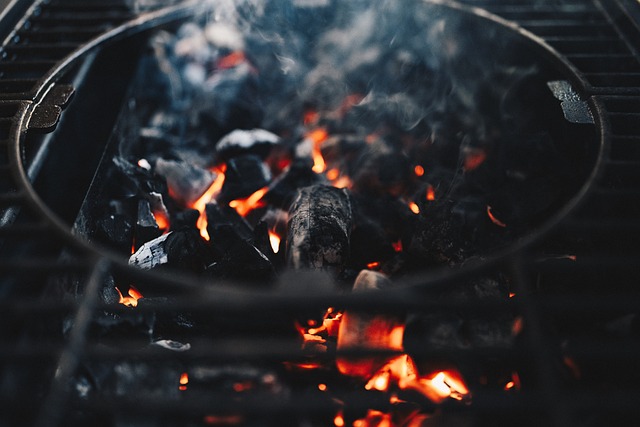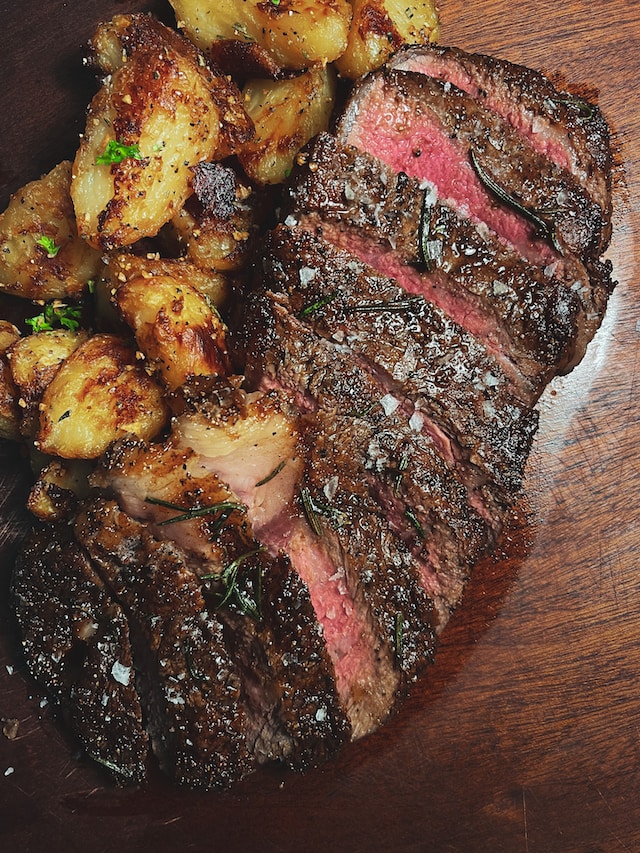Grilling Frozen Steak: Secrets to Perfect Flavor & Texture
There’s a deeply rooted belief in culinary circles about the “right” way to prepare and cook meats, especially something as prized as a steak. Grilling frozen steak breaks nearly all traditional guidelines, which is why it’s surrounded by such intrigue and debate.
Why some chefs swear by it
For those who champion this method, the results speak for themselves. Here’s why they’re big fans:
Intense Maillard Reaction: Grilling a frozen steak creates a more pronounced Maillard reaction, that amazing process where the amino acids and reducing sugars in the meat give you that browned, flavorful crust. Since the interior of the steak is frozen, it allows the outer layers to develop a deep sear without overcooking the inside.
Consistent Juiciness: As the inside thaws and cooks slowly, it retains its moisture. This contrast between the crispy exterior and moist interior is unparalleled. Remember those mouth-watering steaks at high-end restaurants? This method can help replicate that.
Adventurous Culinary Experience: Pushing the boundaries is what cooking is all about! Grilling a frozen steak is unconventional and offers a different kind of fun and challenge.
Why others are skeptical
And for the doubters, it’s not just about being sticklers for tradition. They have their reasons:
Even Cooking Concerns: The primary concern is the potential for uneven cooking. With the exterior getting hot so quickly, there’s a fear the inside will remain cold or raw.
Texture Differences: Some argue that the texture of a steak grilled from frozen can differ from one that’s been properly thawed. The slower melting of the internal fat might not provide the same marbling effect.
Taste Testimonials: Taste is subjective. While some adore the contrast of crispy and juicy, others prefer the uniformity in a traditionally grilled steak.
The “Right” Way: For many, grilling is not just about the end product but the ritual. The process of selecting the steak, letting it come to room temperature, seasoning, and then grilling is a cherished routine.
Potential Health Concerns: There’s a belief that grilling frozen meat might not kill bacteria or parasites as effectively as grilling thawed meat. However, if grilled to the right internal temperature, this shouldn’t be an issue.

Why you should try Grilling Frozen Steak
While grilling frozen steak might seem unconventional, it does come with a slew of benefits that might make you reconsider your grilling strategy.
Enhanced flavor retention
Locking in the Goodness: The rapid searing of the cold, frozen exterior creates a seal, trapping in the steak’s natural juices. This results in a flavorful steak, as the moisture doesn’t get a chance to evaporate quickly.
Better Maillard Reaction: As mentioned earlier, the Maillard reaction is that wonderful process responsible for the browned, flavorful crust on meats. A frozen steak has a distinct advantage in this department. The cold insides slow down the overall cooking process, letting the exterior get a deeper sear, which amplifies the steak’s savory tastes.
Spice and Seasoning Penetration: Ironically, because the frozen steak needs a bit more seasoning than a thawed one, you end up with a steak that has a more robust flavor profile. The extended grilling time allows the salt and seasonings to work their way into the steak, enhancing its natural flavors.
Reduced cooking time
No Waiting for Thawing: Thawing a steak can be a time-consuming process. Especially if you’re using the recommended method of refrigerating the steak for safe thawing, it can take hours. Grilling a steak directly from the freezer bypasses this wait.
Direct to Grill: While it might sound counterintuitive, grilling frozen steak can often be quicker than its thawed counterpart. The reason? You’re essentially searing the outside rapidly while allowing the inside to gradually come to temperature. This process can result in a reduced overall grill time, especially when you factor in the thawing time you’ve skipped.
Safer meat handling
Bacterial Growth Prevention: Keeping the steak frozen until it hits the grill reduces the risk of harmful bacterial growth. When thawing meat at room temperature, there’s a potential for bacteria to multiply rapidly.
Reduces Cross-contamination Risks: Handling raw meat always has its risks. By reducing the number of steps where you’d handle the steak (like moving it around during thawing), you’re minimizing the chances of cross-contamination in your kitchen.
Maintains Meat Integrity: Freezing and then directly grilling preserves the structural integrity of the meat. Thawing, especially if done improperly, can sometimes lead to a mushy texture or loss of moisture. Grilling from frozen ensures the steak retains its original texture and feel.

The Perfect Technique for Grilling Frozen Steak
Having a go at grilling frozen steak requires a bit more than just a leap of faith. Precision, the right tools, and a few tweaks to the traditional grilling method make all the difference. Let’s break down the perfect technique.
Prep: The initial steps
Before you even think of placing that steak on the grill, there’s some preparatory work to ensure your steak is grilled to perfection.
Seasoning
The frozen exterior of the steak can be a bit tricky when it comes to seasoning, but with a few adjustments, you can ensure maximum flavor:
1. Generosity is Key: A frozen steak requires a liberal amount of seasoning. The cold, hard surface might initially repel some of your seasoning, so being generous ensures ample coverage.
2. Coarse Over Fine: Coarse seasonings, like kosher salt or coarse ground pepper, adhere better to the frozen surface. The larger grains also provide a better crust when searing.
3. Herbs and Pastes: If you’re a fan of herb pastes or rubs, consider applying these after the initial sear. This prevents the herbs from burning and allows them to meld with the steak as it cooks over indirect heat.
4. Oil? Maybe Later: Traditionally, you might oil your steak before seasoning, but with frozen steaks, it’s better to brush some oil on the grates of your grill instead. The frozen surface won’t allow the oil to adhere well.
Setting up the grill
The grill setup is essential, especially when you’re working with a steak that’s rock solid and cold at its core:
1. Two-zone Fire: The trick is to set up a two-zone fire. One side of your grill should be scorching hot (direct heat) for searing, while the other side should be cooler (indirect heat) to allow the steak to cook internally without burning the outside.
2. Clean and Oil the Grates: A clean grill is a non-stick grill. Before heating, make sure to brush the grates clean. Once hot, use tongs to hold a paper towel soaked in oil and brush it over the grates. This ensures your steak doesn’t stick.
3. Lid Down: Keeping the lid down helps in maintaining an oven-like environment. This is especially crucial for frozen steaks, as the internal cooking takes a tad longer.
4. Monitor the Temperature: If you’re using a charcoal grill, you might need to adjust the number of coals or their distribution to maintain the right heat levels. For gas grills, adjusting the dials should do the trick. Remember, you want a blazing hot side for searing and a cooler side to finish cooking.
5. Tools at the Ready: Have a reliable pair of tongs, a meat thermometer, and possibly a timer on hand. Grilling frozen steak is a bit more of a science, and you’ll need these tools to ensure perfection.

Time frames and temperatures
The exact time and temperature can vary based on the thickness of your steak and your grill’s heat consistency. However, here’s a general guide to navigate this frozen steak grilling journey:
1. Initial Searing: Start by placing the frozen steak on the direct heat side of the grill. You’ll want to sear each side for about 1-2 minutes to lock in those juices and achieve a crispy crust. If your steak is particularly thick, consider searing the edges as well.
2. Indirect Cooking: Once seared, move the steak to the cooler, indirect heat side. For a 1-inch thick steak, you’re looking at about 10-15 minutes of cooking per side. If your steak is thicker, you’ll need to adjust the time accordingly.
3. Temperature Check: The internal temperature for a medium-rare steak should be around 130°F (54°C). For medium, aim for 140°F (60°C). Always remember, the steak will continue to cook a bit even after it’s off the grill, so account for an additional 5°F (3°C) rise in temperature when resting.
4. Rest and Repeat: After grilling, let your steak rest for at least 5 minutes. This allows the juices to redistribute. If after resting, you find that the steak’s interior isn’t as done as you’d like, don’t fret. You can always throw it back on the indirect heat side for a few more minutes.
Checking for doneness
As crucial as time frames are, the real testament to a perfectly grilled steak is its doneness. Here’s how to ensure you hit the mark:
1. Invest in a Meat Thermometer: This isn’t just a suggestion; it’s a mandate. Especially with frozen steaks, the exterior can be deceiving. A meat thermometer is your best friend in ensuring the inside is cooked to your liking.
2. Touch Test: Some seasoned grillers swear by this method. Open your palm, relaxed. The base of your thumb, that fleshy part, feels like a rare steak. Touch your thumb and index finger, and that base feels like medium rare. Thumb and middle finger, medium. And so on. Press on your steak and compare.
3. Visual Cues: Once you think it’s done, you can make a small cut to peek inside. The color can give you a good indication. Remember, it’s better to be slightly under than over since you can always cook it a bit more.
4. Resting: As mentioned earlier, a steak continues to cook even after it’s off the grill. Resting allows the meat fibers to relax, absorb, and redistribute the juices. Plus, it ensures you don’t get a false reading on its doneness.

Mistakes to Avoid When Grilling Frozen Steak
Even as you’re armed with the right techniques and tips, there are pitfalls on grilling frozen steak. Being aware of these common mistakes can be the difference between a charred chunk of meat and a delectable dinner.
1. Skipping the Sear: As tempting as it might be to just toss the steak on the cooler side of the grill, that initial sear is crucial. It locks in juices and gives the steak its flavorful crust.
2. Over-seasoning: While frozen steak requires a generous hand with seasoning, there’s a fine line between flavorful and overly salty. Remember, you can always add more seasoning later.
3. Not Preheating the Grill: Starting with a grill that’s not hot enough won’t give you the sear you need. Preheat, and ensure you have those distinct heat zones set up.
4. Using a Dull Knife: When it’s time to check for doneness or serve, a sharp knife can make a world of difference. Dull knives can tear the meat, letting those precious juices escape.
5. Impatience: Grilling frozen steak is a bit of an art. Rushing the process, not letting the steak rest, or continuously flipping it can ruin your efforts.
6. Forgetting Safety: From ensuring the steak is stored correctly in the freezer to handling it safely during grilling, never compromise on safety for the sake of speed or convenience.
Conclusion
Grilling frozen steak breaks the boundaries of traditional thaw-then-grill methods, proving that sometimes, the unconventional path yields the most delightful results. From the golden crust achieved through that initial sear to the juicy, flavorful insides, the results speak for themselves. It’s about understanding the science, mastering the technique, and avoiding common mistakes.
FAQs
1. Can I really grill a steak straight from the freezer?
Absolutely! Grilling a steak directly from the freezer can lead to a delightful crust on the outside while keeping the inside tender and juicy. Just ensure you follow the correct techniques and timings for optimal results.
2. Does grilling a frozen steak alter its taste compared to a thawed one?
Not negatively. In fact, many advocates of the method argue that grilling from frozen can enhance flavor retention. The process might give a more pronounced contrast between the seared exterior and the tender interior, delivering a unique taste experience.
3. How do I adjust my grilling time for different cuts or thicknesses of frozen steak?
Generally, thicker cuts will require more time, especially during the indirect cooking phase. It’s recommended to use a meat thermometer to monitor the internal temperature for precision. A standard 1-inch steak might need 10-15 minutes on each side over indirect heat after searing, but always adjust based on the steak’s thickness and desired doneness.
4. Is there any steak cut that isn’t suitable for grilling from frozen?
Most steak cuts can be grilled from frozen with the right technique. However, very thin cuts, like minute steaks, can easily overcook due to their size. In such cases, it might be better to thaw them first for better control over the grilling process.
5. What’s the main advantage of grilling frozen steak over the traditional thawed method?
Apart from convenience, grilling frozen steak can offer enhanced flavor retention and a crispier crust. Additionally, it can also be viewed as safer since there’s a reduced risk of bacterial growth compared to meat that’s been left out to thaw for extended periods.





Comments are closed.